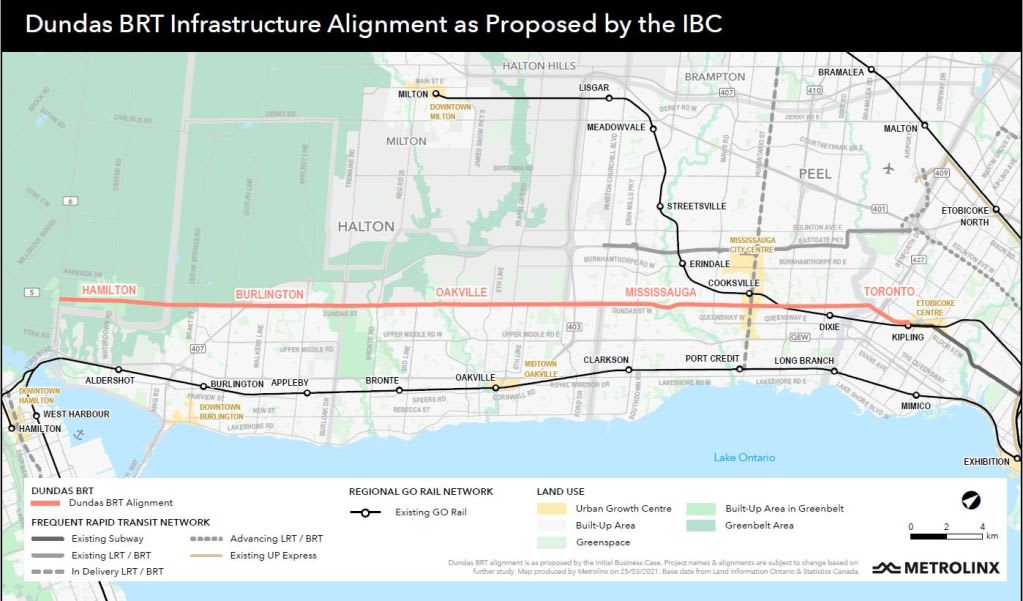Closer look Dundas bus rapid transit virtual engagement
Get the latest info on the proposed transit project and engagement opportunities below.
Sep 2, 2021
If you aren’t familiar with the Dundas bus rapid transit (BRT) project, now is your chance, including giving your input.
In partnership with the City of Mississauga, Metrolinx introduced the Dundas BRT project to residents and businesses in April 2021.
Right now, there’s no continuous east-west transit service along Dundas Street, which impacts connectivity and accessibility for residents, workers, and commuters.
That’s where the Dundas BRT project comes in.
The project is meant to connect the 48-kilometres of Dundas Street – running through Toronto, Mississauga, Oakville, Burlington, and Hamilton from Highway 6 in the City of Hamilton all the way through to Kipling Station in Toronto.
It will allow for faster, reliable, and frequent bus service along Dundas Street as well as provide connections to other transit services and key destinations along the corridor.
Metrolinx is in the process of studying the project and this includes three Transit Project Assessment Processes (TPAPs), and one Preliminary Design Business Case (PDBC) for the following sections of the project:
- Toronto – Kipling Transit Hub to Etobicoke Creek
- Mississauga East – Etobicoke Creek to Confederation Parkway (this TPAP will be conducted first to meet federal funding requirements)
- Mississauga West – Confederation Parkway to Ninth Line
For the Halton and Hamilton sections, from Ninth Line to Highway 6, there is no TPAP required. Through Halton, much of the corridor has already been studied under various Municipal Class Environmental Assessments and widened to six lanes.
Through Hamilton, it is anticipated that only operational and localized design modifications are required, which are exempt from Environmental Assessment Act requirements.
This second round of public engagement provides updates to the environmental studies done to date and shares some of the progress on preliminary design for the Mississauga East part of the BRT corridor. An analysis of options to build the BRT through constrained areas and the impacts of those options, plus the proposed stops for Mississauga East are open for the public to review and comment.
As preliminary design work for Toronto, Mississauga West, Halton, and Hamilton is still underway, more information related to pinch points, proposed stop location and potential amenities in these areas will be presented during a future public engagement session.
Metrolinx wants your input: Making room for the Dundas BRT project
In Mississauga, Dundas Street will need to be widened to create room for the dedicated median BRT lane that will improve transit speed and reliability. The widening of Dundas will allow for four general purpose traffic lanes, bike lanes, wider sidewalks and amenity space for utility poles, trees, and things like benches.
To accommodate the widened corridor, there will be property impacts in certain areas along Dundas Street. These impacts may include removing existing structures, altering parking spaces, entrances and exits, landscaping, or other features.
As design progresses, Metrolinx will look at opportunities to lessen potential impacts to properties where possible, for example, developing minimum standards for design elements such as lane widths and platform widths.
An example of curbside bus rapid transit with reserved bus lanes on Dundas Street. (Metrolinx image)
It is essential to Metrolinx that the people who live and work in any community are consulted and engaged as work continues towards a final design. The current virtual public engagement is the second of four formal opportunities for people to share their thoughts and suggestions.
An example of median BRT on Dundas Street. (Metrolinx image)
Pinch points
During the last engagement, two pinch points, or constrained areas, were identified within Mississauga. In Cooksville (Mississauga East) a dense mix of existing structures close to the proposed route and some heritage properties mean design will have to consider the varying impact on the community character of Cooksville Village as protecting and enhancing this area is priority.
The Dundas BRT project team has arrived at six possible alternatives, with technical analysis further narrowing that to three feasible options:
- Alternative 1 – Full median lane BRT corridor (with two general purpose lanes in either direction)
- Alternative 3 – Full median BRT corridor with no lefts allowed at the Dundas Street and Hurontario Street intersections
- Alternative 4 – Curbside buses in mixed traffic
Residents will have the opportunity to hear directly from the technical team responsible for the Mississauga analysis and design, including the Cooksville area, through a live meeting hosted on Metrolinx Engage on September 22 from 6:30 – 7:30 p.m. Use this link to register and submit your questions in advance.
Erindale Valley (Mississauga West) is the second pinch point, because of the need to protect the surrounding natural environment and several heritage sites. Currently, two alternatives are being assessed for Erindale (Mississauga West). More information will be available during the next round of public engagement.
Stop locations
Since the last round of public engagement, work has advanced on establishing the proposed stop locations and amenities. Eight stop locations were identified in Mississauga East and are based on:
- The Dundas Connects Study and the Initial Business Case
- Current transit facilities and intersecting bus routes that form the basis of a connected network
- Distance between stops
- Land use and major trip generators
A look at the proposed stops along Dundas Street. (Metrolinx image)
The distance between each Dundas BRT stop location will be determined by the unique nature of the areas the BRT will travel through. Increased spacing between stops will allow for faster and reliable service along the corridor.
Get Involved
Have questions, comments, or concerns about the Dundas BRT project? The team wants to hear from you. Visit metrolinxengage.com/dundasBRT today to learn more about the Dundas BRT project and share your input. This round of public engagement will run until September 23.
by Erika D’Urbano Communications senior advisor
